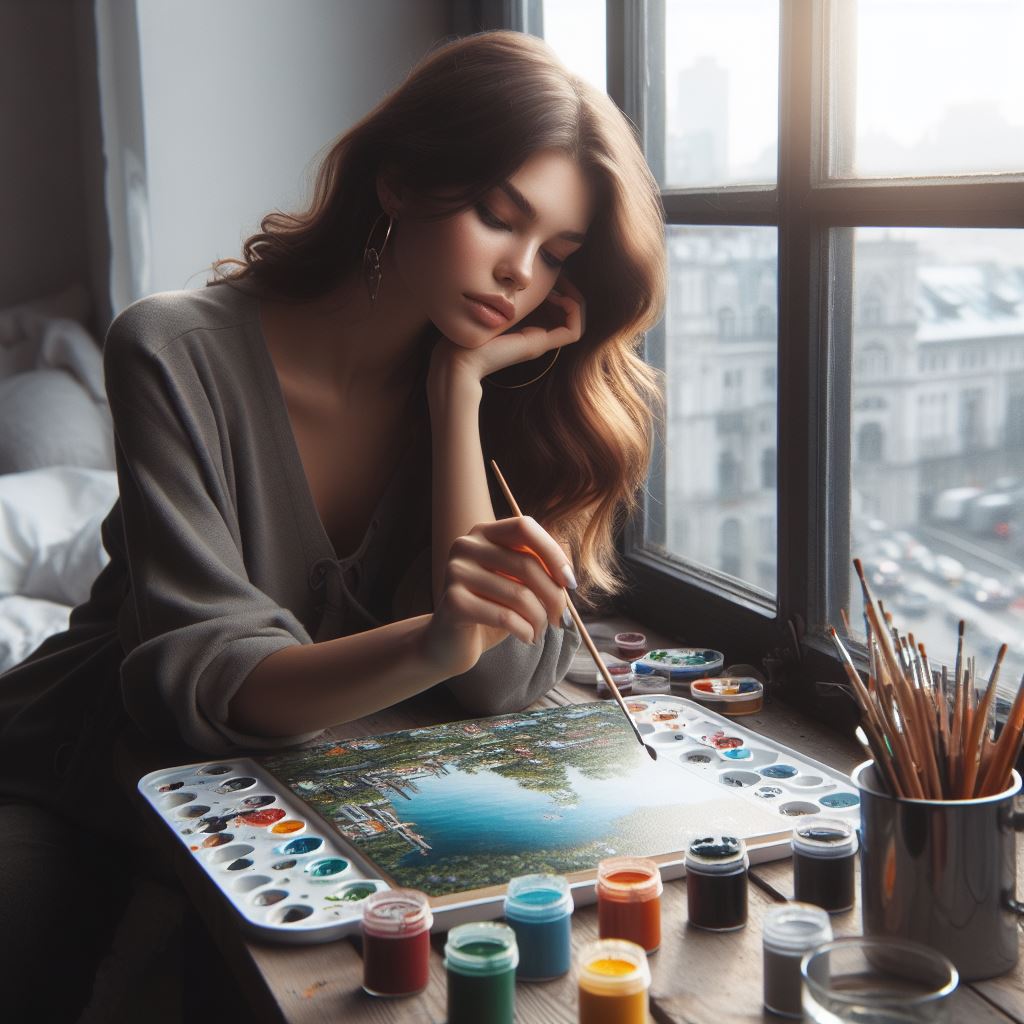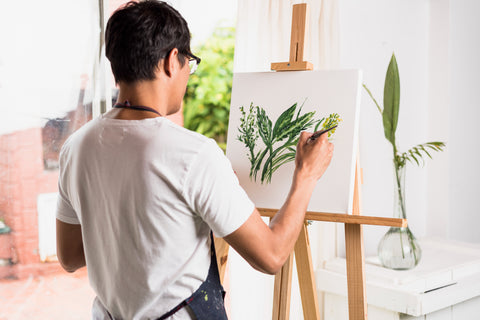
Tipps für Anfänger, die ein Malen-nach-Zahlen-Projekt starten
Aktie
Wenn Sie in die Welt von Malen nach Zahlen eintauchen, ist es wichtig, sich mit einigen Kenntnissen und Techniken auszustatten, um ein erfolgreiches Ergebnis Ihres Projekts sicherzustellen. Lesen Sie weiter, um einige wertvolle Tipps und Einblicke zu erhalten, die Ihnen helfen, Ihr erstes Malen-nach-Zahlen-Projekt voller Zuversicht zu beginnen!
Erste Schritte mit Ihrem ersten Malen-nach-Zahlen-Projekt
Der Beginn Ihres ersten Malen-nach-Zahlen-Projekts ist ein spannendes Unterfangen, bei dem Sie Ihrer Kreativität freien Lauf lassen und ein wunderschönes Kunstwerk schaffen können. Es kann aber auch ein wenig einschüchternd sein, wenn Sie Ihre künstlerischen Fähigkeiten noch nie erkundet haben. Das Beste an einem Malen-nach-Zahlen-Malprojekt ist jedoch, dass Sie Ihr verborgenes Potenzial leichter und einfacher entfalten und dabei trotzdem wunderschöne Kunstwerke schaffen können.
Wählen Sie Ihr erstes Malen-nach-Zahlen-Set
Der erste Schritt besteht darin, ein Malen-nach-Zahlen-Set auszuwählen, das Ihren Interessen und Ihrem Können entspricht, insbesondere wenn Sie ein persönliches Foto verwenden. Berücksichtigen Sie bei der Auswahl oder Zusammenstellung Ihres Sets die folgenden Faktoren:
- Motiv: Entscheiden Sie sich für die Art des Bildes, das Sie malen möchten. Es könnte eine Landschaft, ein Tier, ein Stillleben oder sogar ein Porträt sein. Wählen Sie unbedingt etwas, das Sie wirklich anspricht und Ihre Begeisterung weckt. So bleiben Sie inspiriert und gehen Ihr Projekt mit Begeisterung und Sorgfalt an.
- Komplexität: Berücksichtigen Sie Ihr aktuelles Können und den Grad der Komplexität, mit dem Sie sich wohl fühlen. Anfänger sollten mit einfacheren Designs beginnen, während erfahrenere Maler sich für anspruchsvollere und detailliertere Sets entscheiden können. Wählen Sie zu Beginn ein Set mit weniger Farbtönen und wechseln Sie mit zunehmenden Fähigkeiten zu Sets mit mehr Farbtönen und feinen Details.
- Größe: Bestimmen Sie die Größe der Leinwand. Kits sind in verschiedenen Größen erhältlich. Wählen Sie also eines aus, das den gewünschten Abmessungen Ihres fertigen Kunstwerks entspricht. Überlegen Sie dabei, ob Sie für Ihr Projekt einen Rahmen benötigen.
- Qualität: Das Malen-nach-Zahlen-Set Ihrer Wahl enthält Materialien wie die vorgedruckte Leinwand, Pinsel und einen Satz nummerierter Acrylfarben, die den auf der Leinwand angegebenen Zahlen entsprechen. Möglicherweise möchten Sie jedoch noch weitere hochwertige Pinsel in verschiedenen Größen, eine Palette zum Mischen der Farben nach und nach und eine Staffelei zum ergonomischen Malen hinzufügen.
Informationen zu den im Kit enthaltenen Verbrauchsmaterialien
Sobald Sie Ihr Set erhalten haben, machen Sie sich mit den enthaltenen Materialien vertraut.
- Vorgedruckte Leinwand: Dies ist die Grundlage Ihres Kunstwerks. Die Abschnitte werden durch Nummern gekennzeichnet, die bestimmten Farben entsprechen.
- Farben: Ihr Set enthält einen Satz Acrylfarben, die mit Nummern beschriftet sind, die den Abschnitten auf der Leinwand entsprechen. Diese Farben sind auf Wasserbasis und leicht zu verarbeiten.
- Pinsel: Ihr Set enthält einen Satz Pinsel, die für verschiedene Bereiche und Details Ihres Gemäldes geeignet sind. Sie möchten aber vielleicht noch einmal zusätzliche Pinsel bestellen, falls einer kaputt geht oder verlegt wird.
- Farbschlüssel: Es wird ein Farbschlüssel oder eine Farbtabelle bereitgestellt, die angibt, welche Nummer welcher Farbe entspricht. Dies hilft Ihnen beim Ausfüllen der Abschnitte mit der entsprechenden Farbe. Wir empfehlen außerdem, vor Beginn des Malens ein Nahaufnahmefoto Ihrer Leinwand zu machen. Dies dient als zusätzliche Anleitung.

Techniken zur Perfektionierung Ihrer Malen-nach-Zahlen-Fähigkeiten
Wenn Sie alle Ihre Materialien bereitgelegt haben, stellen Sie sicher, dass Sie einen komfortablen Arbeitsplatz haben, der sauber und frei von Unordnung und Ablenkungen ist. Stellen Sie außerdem sicher, dass die Beleuchtung hell genug ist, damit Sie Ihre Arbeit deutlich sehen können. Vielleicht möchten Sie Ihr Projekt liegen lassen, damit Sie problemlos darauf zurückkommen können, wenn die Zeit es erlaubt.
So verwenden Sie die Pinsel richtig
- Beginnen Sie mit einem sauberen Pinsel: Bevor Sie Ihren Pinsel in die Farbe tauchen, stellen Sie sicher, dass er frei von vorheriger Farbe ist. Spülen Sie den Pinsel mit Wasser aus und tupfen Sie ihn mit einem Papiertuch trocken. Halten Sie ein Glas mit Wasser zum Ausspülen bereit und einen Lappen oder ein Papiertuch, um den Pinsel nach dem Ausspülen abzutrocknen.
- Verwenden Sie die richtige Pinselgröße: Verschiedene Abschnitte der Leinwand erfordern unterschiedliche Pinselgrößen. Verwenden Sie kleinere Pinsel für komplizierte Details und größere Pinsel für breitere Bereiche.
- Tragen Sie die Farbe mit sanften Strichen auf: Tauchen Sie den Pinsel in die Farbe und tragen Sie sie auf den entsprechenden nummerierten Abschnitt auf der Leinwand auf. Füllen Sie den Bereich mit sanften Strichen aus und sorgen Sie für einen gleichmäßigen und konsistenten Farbauftrag. Beginnen Sie mit weniger Farbe, bis Sie mit Ihrem Pinselstrich zufrieden sind, und erhöhen Sie dann die Menge, bis der Abschnitt gleichmäßig bedeckt ist. Beginnen Sie mit einem größeren Abschnitt, um ein gewisses Maß an Sicherheit mit dem Pinsel und dem Farbauftrag zu entwickeln.
- Reinigen Sie den Pinsel zwischen den Farben: Wenn Sie zu einer anderen Farbe wechseln müssen, spülen Sie den Pinsel gründlich aus und trocknen Sie ihn, bevor Sie ihn in die neue Farbe tauchen. Dadurch wird eine Farbmischung vermieden und lebendige und präzise Ergebnisse sichergestellt. Mit zunehmender Erfahrung kann es vorkommen, dass Farbmischungen und -überlappungen für ein bestimmtes Projekt, z. B. eine Landschaft, geeignet sind. Vermeiden Sie jedoch vorerst das Mischen von Farben.
Das Nummerierungssystem verstehen
- Folgen Sie den nummerierten Abschnitten: Jeder Abschnitt auf der Leinwand ist mit einer Nummer markiert, die einer bestimmten Farbe entspricht. Wie Sie die Abschnitte angehen, ist unterschiedlich. Es gibt kein Richtig oder Falsch, aber wenn Sie Ihr erstes Projekt abschließen, sollten Sie vielleicht mit dem größten Abschnitt beginnen und dabei sehr darauf achten, keinen der kleineren, komplizierteren Abschnitte zu übermalen. Oder Sie können mit der niedrigsten Nummer beginnen und von dort aus mit dem Malen beginnen.
- Gehen Sie systematisch vor: Um ein Verschmieren oder versehentliches Malen des falschen Abschnitts zu vermeiden, gehen Sie systematisch vor. Beginnen Sie auf einer Seite der Leinwand und arbeiten Sie sich zur anderen vor. Stellen Sie sicher, dass die bemalten Abschnitte trocken sind, bevor Sie mit angrenzenden Bereichen fortfahren. Wenn Sie mit einer Staffelei arbeiten, können Sie Ihr Gemälde jederzeit umdrehen, sodass Sie bequem arbeiten können, ohne über fertige Abschnitte greifen und Ihren Arbeitsarm ermüden zu lassen. Wenn Sie mit einer Staffelei malen, die auf Ihrem Arbeitsplatz aufgestellt ist, können Sie eine entspannte Haltung beibehalten, während Sie aufrecht sitzen, und so unerwünschte Nacken- und Schulterschmerzen vermeiden. Nehmen Sie sich Zeit zum Dehnen, wenn Sie über längere Zeit arbeiten.

Häufige Herausforderungen für Anfänger und wie man sie überwindet
Umgang mit kleinen, schwierigen Bereichen
- Verwenden Sie einen kleineren Pinsel: Wenn Sie mit kleinen und komplizierten Bereichen arbeiten, wechseln Sie zu einer kleineren Pinselgröße, die eine höhere Präzision ermöglicht. Auf diese Weise können Sie die winzigen Abschnitte präzise ausfüllen, ohne zu verwischen oder über die Linien hinauszugehen.
- Nehmen Sie sich Zeit: Geduld ist der Schlüssel, wenn Sie an kleinen Flächen arbeiten. Nehmen Sie sich Zeit und arbeiten Sie langsam, um sicherzustellen, dass jeder Abschnitt mit der richtigen Farbe ausgefüllt ist. Verwenden Sie kontrollierte Pinselstriche, um die Genauigkeit zu wahren.
- Verwenden Sie Vergrößerungswerkzeuge: Stellen Sie eine Lupe auf Ihren Arbeitsplatz, damit Sie Detailbereiche besser erkennen können. Dies kann bei der Arbeit an diesen schwierigen kleinen Bereichen sehr hilfreich sein.
Was tun, wenn Ihnen die Farbe ausgeht?
- Planen Sie Ihren Farbverbrauch: Analysieren Sie vor Beginn Ihres Projekts die Farben und ihre Mengen. Ihr Set sollte die erforderliche Menge für jeden Abschnitt enthalten. Wenn Sie jedoch davon ausgehen, dass Ihnen eine bestimmte Farbe ausgeht, sollten Sie in den Bereichen, die diese Farbe benötigen, weniger Farbe verwenden oder alternative Farben verwenden, die gut dazu passen.
- Mischen Sie Farben, um einen ähnlichen Farbton zu erzielen: Wenn Ihnen eine bestimmte Farbe ausgeht und Sie keinen Ersatz haben, versuchen Sie, andere Farben zu mischen, um einen ähnlichen Farbton zu erzielen. Experimentieren Sie mit verschiedenen Kombinationen, bis Sie eine ähnliche Farbkombination erzielen. Hier ist eine Farbpalette sehr praktisch!
- Kontaktieren Sie uns: Sollte Ihnen eine bestimmte Farbe einmal völlig ausgehen und Sie keinen passenden Ersatz finden oder herstellen können, können wir Ihnen möglicherweise einen Ersatz liefern oder Ihnen mit alternativen Lösungen helfen, auch wenn das selten vorkommt.
So beheben Sie Fehler
- Handeln Sie schnell: Wenn Ihnen ein Fehler unterläuft, korrigieren Sie ihn am besten schnell, bevor die Farbe trocknet. Wischen Sie die falsche Farbe vorsichtig mit einem feuchten Wattestäbchen ab. Achten Sie dabei darauf, die umliegenden Bereiche nicht zu verschmieren.
- Übermalen Sie den Fehler: Wenn der Fehler nicht leicht entfernt werden kann, können Sie ihn nach dem Trocknen mit der richtigen Farbe übermalen. Verwenden Sie Ihren Farbführer, wenn Sie nicht sicher sind, welche Farbe darunter die richtige ist. Je nach Fehler und Farbe müssen Sie die Farbe möglicherweise in Schichten auftragen oder mit angrenzenden Abschnitten mischen, um ein nahtloses Finish zu erzielen.
Fehler zu machen ist ein natürlicher Teil des Lernprozesses. Lassen Sie sich nicht entmutigen, wenn Sie unterwegs auf Herausforderungen stoßen. Durch die Umsetzung dieser Lösungen können Sie häufige Missgeschicke überwinden und weiterhin schöne Kunst schaffen.

Pflege Ihres Malen-nach-Zahlen-Sets
Die ordnungsgemäße Pflege Ihres Malen-nach-Zahlen-Sets ist wichtig, um seine Langlebigkeit sicherzustellen und die Qualität Ihres Kunstwerkes zu bewahren.
Reinigen Sie Ihre Pinsel
- Pinsel gründlich ausspülen: Spülen Sie Ihre Pinsel nach jedem Malen unter fließendem Wasser aus, um überschüssige Farbe zu entfernen. Achten Sie darauf, alle Farbreste von den Borsten zu entfernen.
- Verwenden Sie eine milde Seife oder einen Pinselreiniger: Verwenden Sie gelegentlich eine milde Seife oder einen speziellen Pinselreiniger, um Ihre Pinsel gründlich zu reinigen. Schwenken Sie die Pinsel vorsichtig in der Seifenlösung, spülen Sie sie gut aus und bringen Sie die Borsten in Form.
- Bürsten richtig trocknen: Wischen Sie nach der Reinigung überschüssiges Wasser vorsichtig ab und bringen Sie die Borsten in Form. Legen Sie die Bürsten flach hin, damit sie vollständig an der Luft trocknen, bevor Sie sie verstauen.
Lagerung unbenutzter Farbe
- Farbbehälter gut verschließen: Um ein Austrocknen der Farbe zu verhindern, achten Sie darauf, dass die Deckel der Farbbehälter nach jedem Gebrauch gut verschlossen werden. Offen stehende Behälter härten nämlich aus und trocknen aus. Sollte dies versehentlich passieren, versuchen Sie, der Farbe durch Zugabe einiger Tropfen Wasser wieder die richtige Konsistenz zu geben.
- Lagern Sie Farben an einem kühlen, trockenen Ort: Suchen Sie einen geeigneten Lagerort, der vor direkter Sonneneinstrahlung und extremen Temperaturen geschützt ist. Wenn Sie die Farben in einer kühlen und trockenen Umgebung aufbewahren, verlängern Sie ihre Haltbarkeit. Ein alter Schuhkarton eignet sich hervorragend!
Bewahren Sie Ihr fertiges Kunstwerk auf
- Lassen Sie das Gemälde vollständig trocknen: Wenn Sie Ihr Malen-nach-Zahlen-Kunstwerk fertiggestellt haben, legen Sie es an einen sauberen und staubfreien Ort, damit es vollständig trocknen kann. Eine Staffelei eignet sich hierfür hervorragend. Berühren Sie sie nicht, bis sie vollständig trocken ist.
- Schützen Sie das Kunstwerk mit einem Fixiermittel: Verwenden Sie zum Schutz Ihres fertigen Kunstwerks ggf. ein Versiegelungsspray. So verhindern Sie, dass die Farben mit der Zeit verschmieren oder verblassen.
- Präsentieren Sie Ihr Kunstwerk: Wählen Sie für die Präsentation Ihres fertigen Gemäldes einen geeigneten Ort, an dem es vor direkter Sonneneinstrahlung, Feuchtigkeit und Staub geschützt ist.
Wenn Sie diese Wartungstipps befolgen, können Sie sicherstellen, dass Ihr Malen-nach-Zahlen-Set in gutem Zustand bleibt, Ihre Pinsel in optimaler Form bleiben und Ihr fertiges Kunstwerk ordnungsgemäß konserviert wird.
Jetzt ist es Zeit, mit Ihrem Malen-nach-Zahlen-Projekt zu beginnen und ein Kunstwerk zu schaffen, auf das Sie stolz sein können!
Viel Spaß beim Malen!
